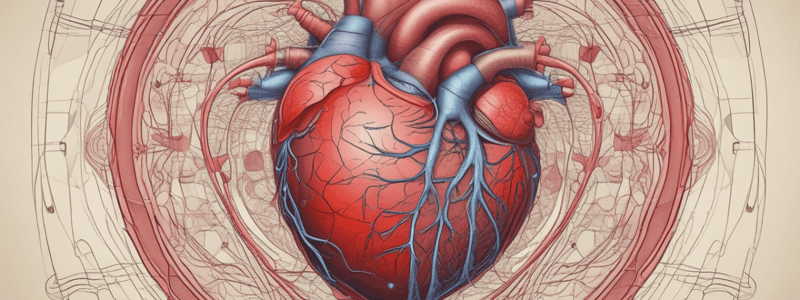Podcast
Questions and Answers
What is the primary function of the heart contractions in the circulatory system?
What is the primary function of the heart contractions in the circulatory system?
- To facilitate the delivery of oxygen and nutrients to tissues and the removal of waste products (correct)
- To remove waste products from the heart
- To pump oxygen and nutrients to tissues
- To increase arterial blood pressure
During which phase of the heart contraction does the heart relax and fill with blood?
During which phase of the heart contraction does the heart relax and fill with blood?
- Venous phase
- Arterial phase
- Systole
- Diastole (correct)
What is measured as the diastolic blood pressure?
What is measured as the diastolic blood pressure?
- The highest pressure on the arterial walls during systole
- The pressure on the venous walls during diastole
- The pressure on the arterial walls during systole and diastole
- The lowest pressure on the arterial walls during diastole (correct)
Why does the arterial blood pressure increase during systole?
Why does the arterial blood pressure increase during systole?
Why is the patient's systolic blood pressure higher while running on a treadmill?
Why is the patient's systolic blood pressure higher while running on a treadmill?
How are blood pressure measurements typically represented?
How are blood pressure measurements typically represented?
What is the result of the increased volume of blood flowing through the arteries during systole?
What is the result of the increased volume of blood flowing through the arteries during systole?
What happens to the blood flow through the arteries during diastole?
What happens to the blood flow through the arteries during diastole?
What is the purpose of measuring systolic and diastolic blood pressure?
What is the purpose of measuring systolic and diastolic blood pressure?
Why does the heart fill with blood during diastole?
Why does the heart fill with blood during diastole?
What is the relationship between systolic blood pressure and physical activity?
What is the relationship between systolic blood pressure and physical activity?
What is the direction of blood flow during systole?
What is the direction of blood flow during systole?
Study Notes
Heart Function and Blood Pressure
- The heart pumps blood through vessels of the circulatory system, providing oxygen and nutrients to tissues and removing waste products like carbon dioxide.
- Blood moves away from the heart through arteries and returns to the heart via veins.
Heart Contraction Phases
- The heart has two distinct phases: diastole and systole.
- During diastole, the heart:
- Relaxes and fills with blood from the veins
- Does not pump blood from the heart
- Has lower blood volume and pressure on arterial walls
- Has lowest arterial blood pressure (diastolic blood pressure)
- During systole, the heart:
- Contracts and forces blood into the arteries
- Has increased blood volume and pressure on arterial walls
- Has highest arterial blood pressure (systolic blood pressure)
Blood Pressure Measurement
- Blood pressure measurements are represented by systolic pressure over diastolic pressure (mm Hg).
- A patient's blood pressure measurement while running on a treadmill was 155 mm Hg, indicating higher systolic blood pressure during physical activity.
Heart Function and Blood Pressure
- The heart pumps blood through vessels of the circulatory system, providing oxygen and nutrients to tissues and removing waste products like carbon dioxide.
- Blood moves away from the heart through arteries and returns to the heart via veins.
Heart Contraction Phases
- The heart has two distinct phases: diastole and systole.
- During diastole, the heart:
- Relaxes and fills with blood from the veins
- Does not pump blood from the heart
- Has lower blood volume and pressure on arterial walls
- Has lowest arterial blood pressure (diastolic blood pressure)
- During systole, the heart:
- Contracts and forces blood into the arteries
- Has increased blood volume and pressure on arterial walls
- Has highest arterial blood pressure (systolic blood pressure)
Blood Pressure Measurement
- Blood pressure measurements are represented by systolic pressure over diastolic pressure (mm Hg).
- A patient's blood pressure measurement while running on a treadmill was 155 mm Hg, indicating higher systolic blood pressure during physical activity.
Studying That Suits You
Use AI to generate personalized quizzes and flashcards to suit your learning preferences.
Description
Learn how the heart pumps blood through the circulatory system, delivering oxygen and nutrients to tissues and removing waste products. Understand the diastole and systole phases of heart contractions.




